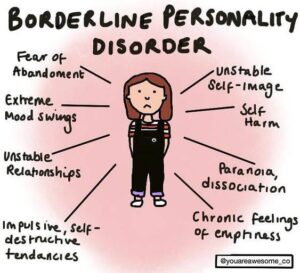When a partner lives with borderline personality disorder, your relationship may, at times, feel like a love-hate cycle. Learning about the condition can help you cope.

A BPD relationship cycle often consists of some emotional highs and lows that may leave you confused and frustrated.
You might also see your partner experience unexpected bouts of anger, anxiety, or depression. They may love you and then suddenly reject you or get upset.
However, borderline personality is a formal mental health diagnosis. It isn’t a personal choice.
Everyone experiences BPD differently, so being in a relationship with someone with BPD may bring its own challenges.
There are different ways to manage these challenges, though, and learning more about the condition could help.
Is there a BPD relationship cycle?
Emotional episodes or cycles are often a reality for people living with borderline personality disorder. This can impact relationships.
“A BPD relationship cycle refers to a repeating, continuous series of highs and lows in a relationship,” explained Tabitha Cranie, a retired MD from St. Petersburg, Florida. “First, everything feels good, uplifting, and safe — they might think of you as their favorite person.”
At the start of the relationship, your partner with BPD might tend to idealize you and everything you do.
They may focus all their attention on you, singing your praises and demanding your attention. They might see only the positives and feel you correspond to their interest and feelings.
As the relationship progresses, idealization may decrease and give room for devaluation.
Your partner may suddenly feel as though you’re not participating in the relationship, don’t care enough, or aren’t meeting them halfway. They may start focusing on negative aspects or having a hard time feeling safe in the relationship.
This idealization and devaluation often occur through what’s informally known as the BPD relationship cycle, or the BPD breakup stages. Although it may seem like a love-hate cycle, it’s actually a progression through stages.
This doesn’t mean that everyone with borderline personality disorder acts in the same ways or repeats the same patterns. But there’s a possibility that some of these behaviors and attitudes are present in a relationship with someone with BPD.
Stages of a borderline personality relationship cycle
The borderline personality relationship cycle may include six stages:
Stage one
Your partner may view you as “the one,” see you as a perfect partner, and prioritize you over other things. This could happen shortly after you’ve met or established a relationship.
They may be demanding of your time and appear fully invested in the relationship.
Stage two
Feelings of anxiety and fear of abandonment may start to appear in your partner.
They may become hypersensitive to some incidents, like a missed text or postponed date.
Symptoms of BPD, like fear of abandonment or stress-related paranoid thoughts, can make your partner believe these isolated incidents mean you’re no longer interested in the relationship or want to leave.
Stage three
In response to fears of abandonment, your partner may begin testing or pushing you away in small ways.
These tests can result in arguments and can be seen by your partner as a way of fighting for the relationship.
Stage four
Without satisfaction or a sense of security from their efforts to test you, a partner living with BPD may resort to intentional distancing. They’ll try to emotionally leave you before you leave them.
This could be confusing for you and painful for them. It may even solidify their perception that the relationship is in trouble.
During this stage, your partner may fixate on thoughts that you’re going to leave, but they may hide these away, maintaining a façade that everything is OK. They could alternately ask you repeatedly to confirm your feelings and interest.
Stage five
If your partner lives with BPD but you remain unaware, this is the stage where the relationship may end.
You may not understand why things have been going downhill. You may feel significantly confused about the changes in your partner’s attitude and behavior.
Your partner living with BPD might try to suddenly explain everything as a last effort to save the bond.
Stage six
If the relationship is over, the partner living with BPD could spiral down into thoughts of low self-worth and experience symptoms of depression.
They may tell themselves they’re worthless or experience such volatile emotions that they engage in some behaviors that may put their safety in jeopardy.
They may also restart the relationship cycle, thinking about how perfect you were and wondering if they can get you back. They might attempt connecting again.
If the relationship doesn’t end and you solve the challenges, they may also restart the cycle.
How long do BPD cycles last?
There is no set timeline for a BPD cycle.
It may take the person with borderline personality a few hours or a few days to go through stages. This doesn’t mean a BPD relationship will be short.
Cranie explained that intense episodes of anxiety, depression, and anger may only last several hours. They could then be followed by a more emotionally stable period.
It may depend on:
- the support your partner has
- accessibility to receive formal treatment
- additional emotional resources they can rely on
Some BPD relationship cycles may take place over months or years, depending on the severity of symptoms.
The expression of BPD symptoms can increase and decrease over time as you grow older. Expressing symptoms, such as emotional lability or impulsive behaviors, can vary in adulthood. Your partner may exhibit symptoms of BPD consistently, occasionally, or not at all.
Researchers indicate that life experiences and nature-nurture interactions between early childhood and adolescence may contribute to symptom expression during adulthood.
Does the BPD relationship cycle always happen?
The BPD relationship cycle isn’t a formal symptom of the condition. There’s also limited research on it.
However, clinical practice and literature have acknowledged it’s a common concern for both people with BPD and their partners.
These stages may not happen at all in a relationship or may be different in each relationship.
In fact, many people with BPD have healthy and successful relationships.
Formal symptoms of borderline personality disorder
To receive a diagnosis of BPD, five or more of these symptoms must be present across situations and over time:
- frantic efforts to avoid abandonment (real or imagined)
- intense, unstable relationship patterns of idealization and devaluation
- persistent and unstable sense of self or self-image
- potentially self-damaging impulsive behavior
- recurrent suicide attempts, suicide ideation, or self-harm
- intense, episodic mood instability
- chronic feeling of emptiness
- uncontrolled or intense, inappropriate anger response
- severe symptoms of dissociation or short term, stress-related paranoia
Clinicians and researchers haven’t yet determined the exact causes of borderline personality disorder. They do know it’s not a personal choice, and it can be challenging to manage.
Trauma, particularly childhood abuse, seems to be one of the contributing factors to the development of symptoms, as well as genetics and brain differences.
Can you have a healthy relationship with someone with BPD?
Yes, it is possible. Living with BPD doesn’t mean you can’t establish stable and healthy relationships.
Some people may believe that the borderline personality disorder relationship cycle is fueled by “self-sabotage.”
Self-sabotage can, in fact, be a feature of some personality disorders. However, in a relationship, self-sabotage can garner displays of love and concern from the partner who has been blamed for not caring.
Since the person with BPD might have a hard time expressing how they feel, these could be attempts to receive reassurance that everything is well.
While this may temporarily meet the needs of the partner living with BPD, ultimately, self-sabotaging may repeat in a BPD relationship cycle.
Relationships are a significant challenge to most people with BPD. These challenges can be managed, typically with professional support.
Your partner’s behavior may be evidence of their difficulty in regulating emotions and their persistently unstable self-image. Quickly changing emotions may also contribute to the relationship cycle.
Your partner with BPD may experience changes in mood, going from feelings of elation and enjoyment to anxiety, insecurity, or distress.
“A romantic relationship with someone with BPD can be, in a word, stormy,” says Cranie. “However, people with BPD can be exceptionally caring, compassionate, and affectionate.”
You and your partner seeking guidance from a mental health professional can help support the possibility of positive change in your relationship.
BPD isn’t a determinant for lack of love or toxic relationships. It just may offer challenges to some people.
How to cope if you’re in a relationship with someone with BPD
Tips to cope when your partner lives with BPD include:
- attending couple’s counseling together
- supporting and encouraging your partner’s desire to seek BPD treatment
- learning about BPD to better understand the symptoms and behaviors
- practicing support and patience during emotional moments
- staying calm during arguments
- setting and explaining boundaries to help prevent toxic behaviors
- making time for self-care and activities that bring you joy
- building a support network for those moments when your partner isn’t available
Let’s recap
When your partner lives with borderline personality disorder, you may find yourself in a relationship cycle of highs and lows.
Your partner isn’t deliberately trying to hurt you or your relationship. Often, they’re internally critical, blaming themselves and not you. This is part of living with a mental health condition like BPD.
While relationships can be challenging when one or both partners have BPD, healthy bonds are still possible.
Learning more about the condition and seeking professional support can be helpful steps.
